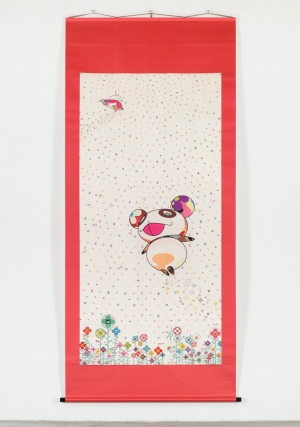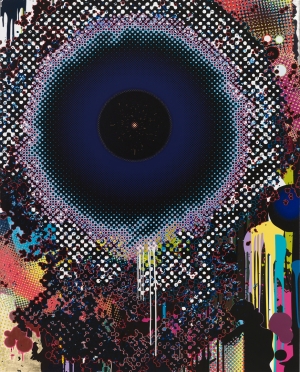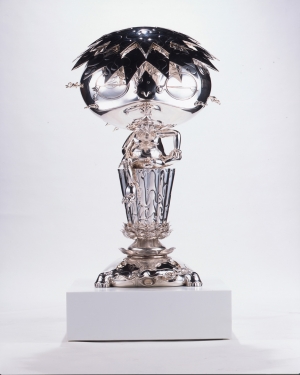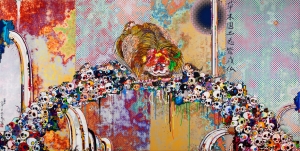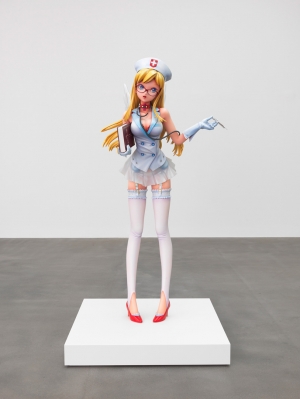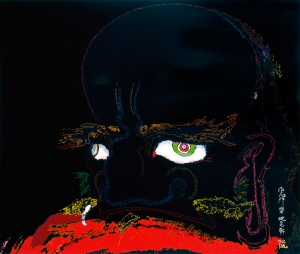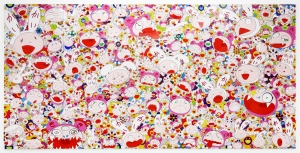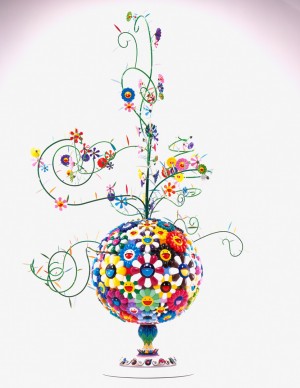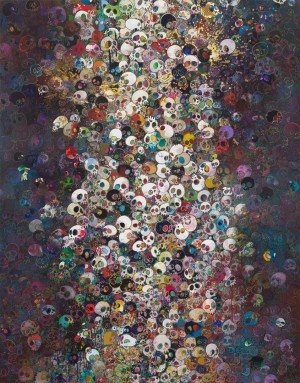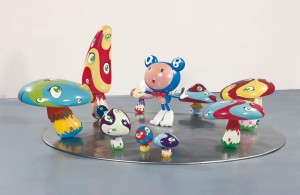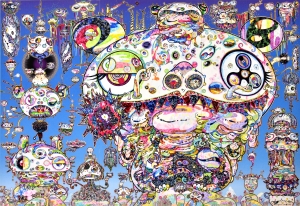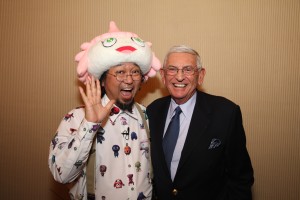
Takashi Murakami
Artist Bio
Takashi Murakami is one of the most visible and important Japanese artists working today. Murakami’s influence on Japan rivals Andy Warhol’s in the United States. Unifying many strands of culture that are frequently considered in opposition—traditional Japanese painting with Western influences, the realm of fine art with otaku lifestyle (culture obsessed with toys, anime, and video games), and commercial retail spaces with museums and other public venues—Murakami’s work is recognized for its ambition, polish, and fine execution. Murakami’s artistic practice is expansive, spilling into fashion, film, and other commercial areas, but his symbols and interests come from deeper impulses.
Mr. DOB is the central character of Murakami’s work. The first iteration of Mr. DOB was in 1994, when the artist was looking at post–World War II Japan. Mr. DOB began as a take on characters from Japanese popular culture, such as Doraemon from a manga series and Sonic the Hedgehog from the video-gaming world, but has evolved over time to absorb societal changes and personal transformations in Murakami’s life, multiplying into other characters like Tan Tan Bo and Panda.
Murakami’s characters Kaikai and Kiki were among the first to evolve out of Mr. DOB, on vibrant view in the painting Hustle ’n’ Punch by Kaikai and Kiki, 2009. Kaikai, dressed in white, is often smiling and happy, while Kiki, in white with vampire fangs in her mouth, is often considered to be mischievous. Together, the characters give their name to Murakami’s company. “Kaikaikiki” is a term from the 16th century that is meant to denote a blend of refinement and eccentricity, two sensibilities that Murakami pursues in his work and commercial ventures.
In Tan Tan Bo, a.k.a. Gerotan: Scorched by the Blaze in the Purgatory of Knowledge, 2018, DOB becomes a monster, floating in the sky and vomiting. Takashi Murakami considers Tan Tan Bo an expression of his pain during an affliction of gout in his feet. Critics have also interpreted the transformation of the character as a metaphor for a society choking on its own excess. The painting is a massive accumulation of figures of varying sizes, each with an elaborately rendered personality, moving the viewer from moments of big visual impact to moments of focused attention.
Around 2009, Murakami began making paintings of Chinese guardian lions, which often stand at the entrances of Chinese temples, palaces, and government offices. Early examples of the series depicted a lion seated on a stone bridge over flowing water; a peony placed on the lion’s forehead symbolized good fortune. For Murakami, Chinese lions and peonies represents cultural exchange and hybridity, as the symbols are as commonly found on Japanese tattoos and old yakuza films as they are on important Chinese buildings. This painting, made around the time of the Tōhoku earthquake transforms the bridge into skulls and features a Buddhist phrase -- Sōmoku kokudo shikkai jōbutsu -- meaning “All grass, trees, and the land itself can attain Buddhahood.”
The most recent work to be on view is Murakami’s Hiroshige’s 100 Famous Views of Edo: Japonisme Reconsidered—Moon Pine, Ueno, 2024–25. In 2024, the artist was invited by the Brooklyn Museum of Art to make work in response to Utagawa Hiroshige’s 100 Famous Views of Edo, 1856-1858. Hiroshige’s woodblock prints are among the most recognizable works of Japanese art for people living outside of Japan and played a vital role in the history of western modernist painting, directly inspiring artists like Vincent Van Gogh and Claude Monet. For these reasons, Murakami chose to directly copy Hiroshige’s work in his own style to understand and channel the excitement that entranced artists like Van Gogh and Monet.
In Japan, it is common to copy the works of one’s teacher as one becomes as an artist. To copy is to honor, to understand, and to eventually learn to develop one’s own voice in relation to the art that came before. Hiroshige’s 100 Famous Views of Edo: Japonisme Reconsidered—Moon Pine, Ueno (2024–25) embodies this tradition. Notably, the pine tree depicted in the painting was famous in Edo at the time of Hiroshige but was later lost during a typhoon. Through impressive horticultural efforts, the city of Tokyo grew a replica of the tree, which resides in Japan to this day.
